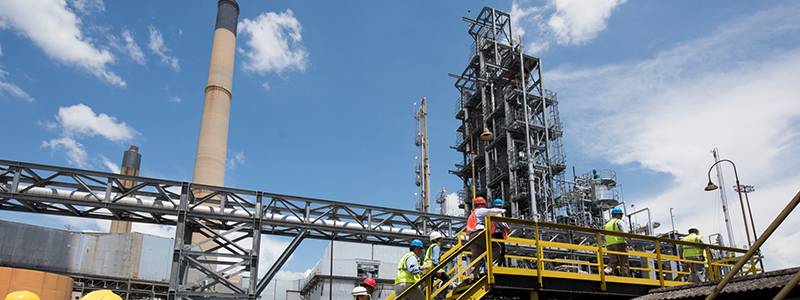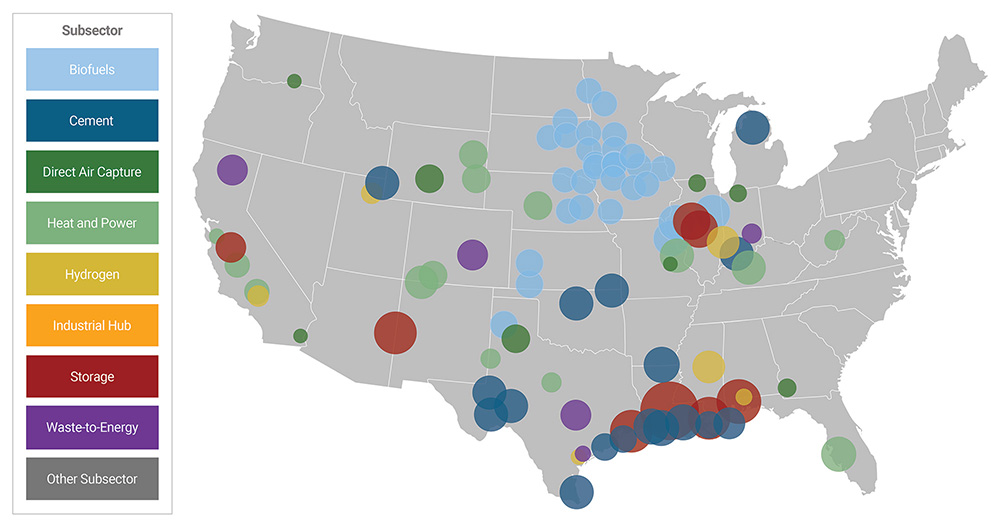Dozens of companies in the energy and industrial sectors are looking to commercialize several technologies that capture and utilize or sequester carbon dioxide (CO2).Today, there are about two dozen operating large-scale carbon capture, utilization and storage (CCUS) projects in the United States and over 60 CCUS projects in various stages of planning and development.
The EPA has since developed a special permitting process through the Underground Injection Control (UIC) program to securely store captured CO2 permanently under the earth’s surface, below impermeable rock, in CO2 injection wells. These wells are called Class VI wells and are for injecting CO2 into the porous space, or “pore space,” between the mineral grains of deep rock formations for long-term geologic sequestration. This is one of six well classes EPA oversees in order to protect underground sources of drinking water.
Injecting gas into a reservoir or the pore space is not a new concept. For over 40 years, companies injected CO2 in an effort to boost energy production. Programs like the Department of Energy’s CarbonSAFE initiative provide funding to identify commercial-scale sites suitable for CO2 storage. Once a site is determined to have good storage capacity and a project secures the correct federal permits, an injection well can be drilled.
Fully Implement Carbon Capture Research and Development Programs- CCUS has experienced a multitude of wins over the past few years, beginning with the Energy Act of 2020. This legislation directed the Department of Energy (DOE) to establish a CCUS commercial demonstration program with the goal of building at least six projects by 2025.
This was quickly followed by the passage of the bipartisan Infrastructure Investment and Jobs Act (IIJA), which contained significant investments in CCUS technology and infused nearly $12 billion into carbon reduction and removal programs. Specifically for CCUS, it appropriates $937 million from 2022 – 2025 for large-scale pilot projects and $2.5 billion from 2022 – 2025 for demonstration projects, both of which were authorized by the Energy Act of 2020. Additionally, it appropriates nearly $2.1 billion for low-interest loans and grants for common carrier CO2 pipeline infrastructure and $2.5 billion for DOE programs for large-scale commercialization of sequestration projects and associated transport infrastructure. This level of investment is on the order of magnitude needed to spur a potential $50 billion CCUS investment over the next five years.
Successful deployment of these technologies is essential. It will be important for the DOE and the Office of Clean Energy Demonstrations to implement these programs expeditiously to ensure the deployment of this crucial decarbonization technology.
Implement Recently Enacted Policies- The federal government has already opened the door for manufacturing facilities to benefit from capturing carbon through the federal carbon capture tax credit 45Q. Continued research and development, in both retrofits and new steel manufacturing processes, can improve the efficiencies and drive down the cost of carbon capture technologies. In addition, the 48C tax credits also should be geared to advance steel carbon capture through Treasury guidance that does not discriminate against steel carbon capture projects. Furthermore, the Office of Clean Energy Demonstrations (OCED) in the U.S. Department of Energy (DOE) is responsible for administering the Advanced Industrial Facilities Program, and should fund steel CCS projects to drive costs down and mature the technology.

Source: National Carbon Capture Center
Clarify CO2 Storage in Various Geologic Formations- Though saline is a popular formation for carbon sequestration, basalt is another known formation well-suited for CO2 sequestration, sometimes referred to as in-situ mineralization. In-situ mineralization has been demonstrated as a viable option to store gigatons of CO2 securely underground. The Wallula Basalt Project, permitted by the State of Washington under their UIC Class V program as a research well, was the world’s first deep basalt supercritical CO2 injection well. The project found that storage through carbon mineralization, where CO2 becomes a solid mineral, was occurring on the order of years significantly faster than current saline formations. The Columbia River Basalt Group, where the Walla Walla Project took place, has the capacity to store up to 50 gigatons of CO2. As written, the UIC Class VI program allows for various formations to be considered for long-term geologic sequestration, but to date, the EPA has not permitted a UIC Class VI well that involves in situ mineralization. Since no wells involving in-situ mineralization in basalt formations have been permitted by the EPA, CO2 operators require clarity that their technology would fall under the UIC Class VI program and ensure they are eligible to claim the 45Q tax credit. Without this clarity, projects that could sequester emissions safely in basalt will be perceived as higher risk by project developers and are less likely to be pursued.
Clarify CO2 Storage on Federal Lands- In 2022, the Bureau of Land Management took the first step to authorize Rights of Ways to allow potential carbon sequestration developers to access pore space. While the current guidance is limited, Congress should seek to provide support in the form of legislation to ensure that agency actions are legal and direct agencies involved in CO2 storage to clarify how CO2 companies can access pore space.
Class VI and Primacy- The federal EPA UIC Class VI permitting program has created many challenges for the cost-effective deployment of carbon capture and sequestration due to significant timeline delays resulting in a lack of certainty for project developers. Despite an over 160 permit application backlog, to date, only two of the six total Class VI wells permitted by EPA are in use for injection, and the permit application processing time was approximately six years for both of these projects. These long and uncertain timelines are a significant barrier to developing the scale of storage capacity required for future carbon management infrastructure.
Fortunately, the EPA is able to grant states primacy, which enables a state to take over the Class VI permitting process, greatly reducing permitting timelines. North Dakota, one of two states along with Wyoming holding primacy, issued its first Class VI well permit in just nine months. State primacy is an important tool for shortening permitting times. EPA should seek to expeditiously approve state primacy applications while establishing clear permitting timelines.
Establish Offshore Storage Regulations- In November 2021, the IIJA directed the Bureau of Ocean Energy Management (BOEM) to promulgate offshore storage regulations that would allow the safe storage of CO2 offshore. BOEM was given one year to develop regulations. However, BOEM missed this Congressionally-mandated deadline. Detailed guidance is the critical first step for the development of large-scale offshore storage options.
Over the last several years, significant foundational work has set up the success of carbon capture technologies, including the following:
Additionally, the most prominent test facility in the United States, the National Carbon Capture Facility, is a public-private partnership between the DOE and companies including Southern Company and ExxonMobil. With successful research in CCUS and carbon conversion for utilization in the production of materials like chemicals and concrete, the facility exhibits the necessity of public-private collaboration in scaling CCUS technology.

CCUS projects are in development across the country for biofuels, cement, direct air capture, heat and power, hydrogen, heavy industry, storage, and other applications.
